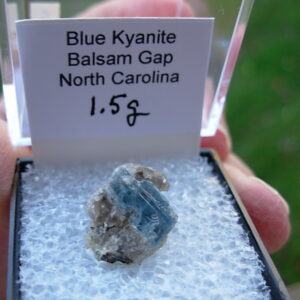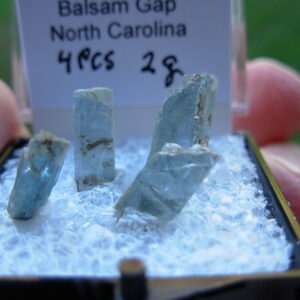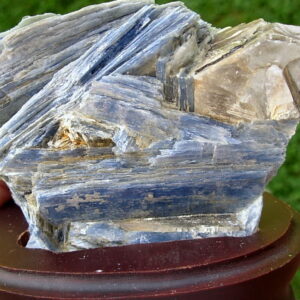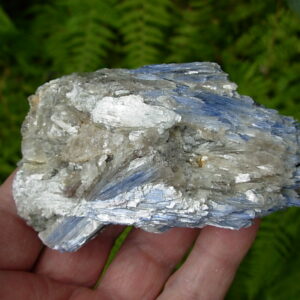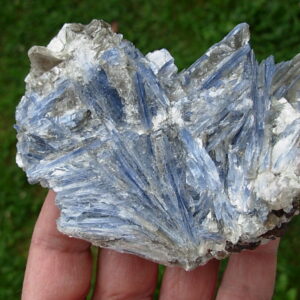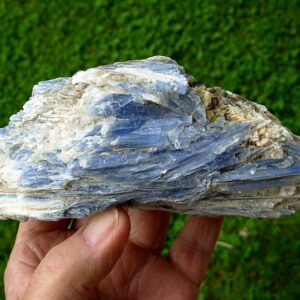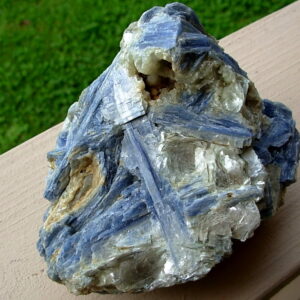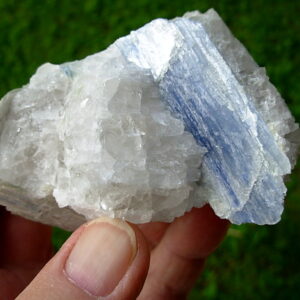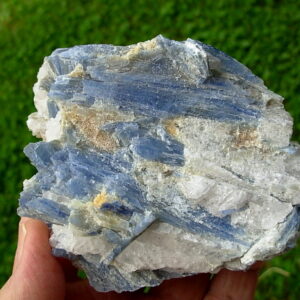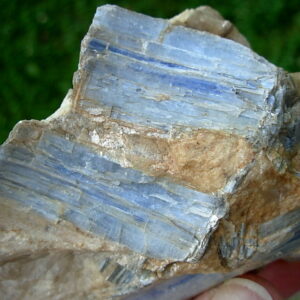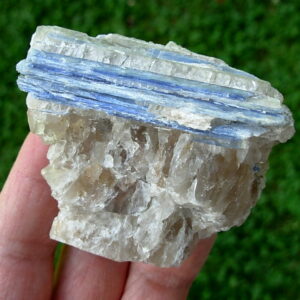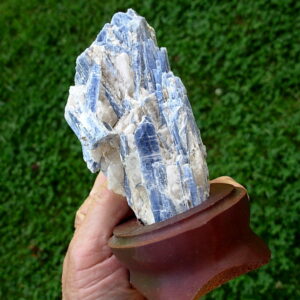Kyanite
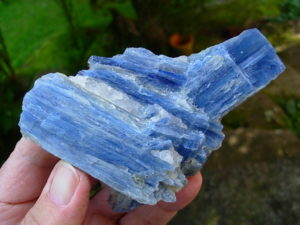 Kyanite forms bladed crystals. It is generally blue, but can also be green or gray. It has a glassy luster. Kyanite has a unique physical feature in that it has two different hardnesses. When its hardness is measured across the crystal it is normally 7 Mohs when it is measured down the length of the crystal however, it is 5 Mohs . All other minerals have a single hardness no matter where it is measured on the crystal. The mineral was once commonly called "disthene" which means "two strengths"
Kyanite forms bladed crystals. It is generally blue, but can also be green or gray. It has a glassy luster. Kyanite has a unique physical feature in that it has two different hardnesses. When its hardness is measured across the crystal it is normally 7 Mohs when it is measured down the length of the crystal however, it is 5 Mohs . All other minerals have a single hardness no matter where it is measured on the crystal. The mineral was once commonly called "disthene" which means "two strengths"
Kyanite is the variant spelling of the original name of this mineral, Cyanite. The name was derived from the Greek word kyanos meaning blue in reference to this mineral’s most common color. The name was given by Abraham Gottlob Werner in 1789.
Three minerals have a chemical composition of Al2SiO5. These are kyanite, andalusite, and sillimanite. Kyanite is the high-pressure polymorph, sillimanite forms at high temperature, and andalusite is the low-pressure polymorph. Sillimanite was named in honor of Professor Benjamin Silliman (1779-1864) who was the first professor of mineralogy at Yale University. Andalusite was named after Andalusia, a province in southern Spain, where this mineral is found.
There are substantial deposits of Kyanite in the United States. The most important deposits are in Idaho and the Appalachian Mountain region in Eastern United States. Gneisses in Southern California also have significant Kyanite resources. Presently, however, it is not economical to mine these deposits. Should economic conditions change, these deposits may be worth mining. South Africa supplies most of the Andalusite imported for industrial consumption in the United States. France and India also produce Andalusite and Kyanite, respectively. The most recent finds of Kyanite have come from Brazil.
Kyanite and its related minerals are used to make a variety of refractory materials. Refractory materials are those that are resistant to very high temperatures. As a result, more than half of the Kyanite consumed is used in refractories for the production of steel. Kyanite is also used to produce refractories for nonferrous (non-iron-bearing) metals. Some is consumed to make refractories for glass and heat-resistant ceramics. Kyanite is also used to make spark plugs and is used for non-refractory applications.
We were able to find a few small thumbnail specimens of the elusive and highly desired mineral Blue Kyanite from the Balsam Gap area in North Carolina. These specimens are the result of over 4 years of searching in this rare locale.
-
1.5g Blue Kyanite from Balsam Gap
$12.00 Add to cart -
4 piece 2g Blue Kyanite Group from Balsam Gap
$24.00 Read more -
Kyanite Blades and Mica Book on Stand from Brazil 2
$129.00 Add to cart -
Kyanite Blades and Quartz from Brazil 11
$22.00 Add to cart -
Kyanite Blades and Quartz with Garnets from Brazil 12
$49.00 Read more -
Kyanite Blades in matrix from Brazil 10
$44.00 Add to cart -
Kyanite Blades in matrix from Brazil 4
$15.00 Add to cart -
Kyanite Blades in matrix from Brazil 7
$78.75 Read more -
Kyanite Blades in matrix from Brazil 8
$24.00 Add to cart -
Kyanite Blades in matrix from Brazil 9
$36.00 Read more -
Kyanite Blades in matrix from Mitchell County, NC 3
$135.00 Add to cart -
Kyanite Blades in matrix from North Carolina 6
$60.00 Add to cart -
Kyanite Blades in Quartz matrix on Stand from Brazil 1
$89.00 Read more

